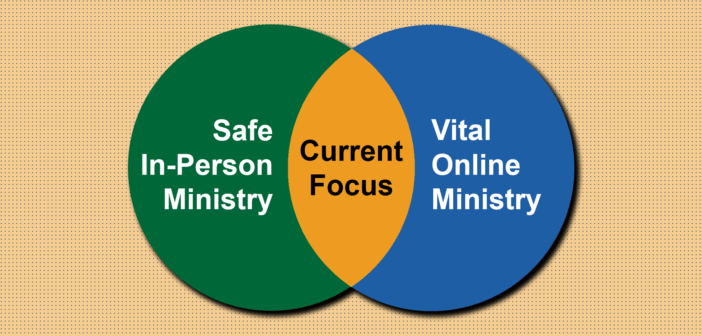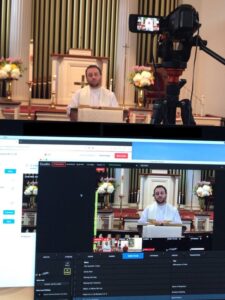
Image Credit: https://www.churchleadership.com/leading-ideas/committing-to-a-hybrid-model-of-ministry/
Introduction
Trinity Church is a historic United Methodist congregation located in the heart of downtown Savannah, GA. In fact, it is so historic, it is listed as one of the official stops along the historical journey of John Wesley’s American Parish. It is also a church that has taken on a culture of inclusion and innovation as part of the heart of its vision for ministry. So when the COVID-19 global pandemic took hold in early 2020, the effort to find new ways to reach new people through technology became a logical response for this congregation.
Online Worship
Early Steps to creating Online Worship:
- We assembled a team of six people, including myself, who would lead music, produce the livestream service, and work sound to ensure people could worship well from their homes.
- The single camera that had previously been in the balcony was relocated to the floor for a more intimate camera angle. Additionally a podium was brought down to the floor to shrink the set and give a more intimate feel for online worship. Since the historic space of the sanctuary was so large, the fear was that it would appear cavernous on camera with an empty room.
- Making eye contact with the camera became a BIG priority! If no one is in the room, one must engage by looking into the camera just as they would if people were physically present in the room. In television terms, this strategy is called “breaking the fourth wall” and is employed as a way to engage people watching on their screens. Transforming the online worshiper from a spectator to an engaged participant is key to online worship.

Taken during one of the first online worship services at Trinity UMC Savannah in 2020 (photo credit: Molly Carlson)
Toward Hybrid Worship
In Fall of 2020 the congregation began to gather for in-person worship again. However, it was then necessary to see worship as a hybrid event because so many remained online.
Next Steps Toward Hybrid Worship:
- Adding words to hymns on camera so online worshipers could sing along at home;
- Adding multiple cameras to offer a more dynamic worship setting with multiple views for people to engage with;
- Adding a new intro and outro video specifically addressing and welcoming people online
One of our most impactful experiments we ran was the addition of a live “sharing of joys and concerns” where people are to share things they were grateful for as well as things they needed prayer for in the comment section on the Facebook livestream event.
This experiment created an online (and now hybrid) practice of weeping with those who weep and rejoicing with those who rejoice (Rom 12). The practice has even evolved into a communal act of prayer as various worshipers comment and click the “like” or “love” or “care” reactions on comments. It ends as people are encouraged to continue to post comments as the pastoral prayer is shared. This extended engagement in the comment section is a way to “pray with your fingers” as participants type in their joys and concerns.
(Sharing of Joys & Concerns at Trinity UMC Savannah)
Small Group Ministry
One of the more interesting developments of using an online platform to create small groups was that it ended up addressing the struggle we had with our physical location being in a busy downtown area with very limited parking. It turned out people were much more likely to join a small group from their kitchen table than they were to drive downtown and pay to park to attend one at our building. The first aim of our online small group ministries was to continue with minimal interruption. But soon we discovered an additional benefit by creating new groups as people were increasingly comfortable using the online platform the longer lockdown continued.
Service & Missions
Service and missions takes a little more creativity when in-person engagement is not possible. Without the ability to serve our community in-person we had to find ways to engage in online mission work.
We found two ways to shift our missions focus:
- Online learning about justice issues: Online small groups focused on the theme of racial justice became a way people could engage in both small group community and mission at the same time without the need for physical proximity.
- Downsizing Mission Outreach: A smaller group within this group has also become active in our local community in an effort to advocate for the changing of the name of one of our historic squares in Savannah from John C. Calhoun Square to Susie King Taylor Square — a change from honoring the legacy of an openly racist politician to honoring the legacy of Savannah’s first African-American activist for equality in public education. The aim of this ended up being creating ways for people to engage more deeply with mission and justice work that involved their heads and hearts and bodies even within the limitations on in-person involvement. This is an example of how online mission can eventually lead to in-person action. Further evidence through feedback members who have taken part in this evolution suggests that online learning and community can complement in-person service and action in important ways moving forward.
Conclusions
Many contemporary theologians have wrestled with the complicated relationship of church and culture, and what it means for the local church to be the present in any host culture. With the universal reach of the Internet, this raises many practical, theological issues. The present study suggests that the two mediums for gathering—online and in-person—should have more of a complementary relationship that adversarial. Therefore understanding the virtues of each medium, and how they can complement one another — even if they cannot always replace one another — is needed in discerning the ways in which online and in-person church can both lead people to faithfulness to God in the life of the church.
Suggested Areas for Further Research
As the world moves beyond the COVID pandemic, churches can benefit from the experience of engaging people with online media. Areas for future research and reflection include:
- How to create online space beyond Sunday for ongoing engagement
Besides social media, what other platforms or tools could be available for ongoing communal engagement online? - Issues surrounding sacramental theology and practices in hybrid ministry
In other words, are there theological and practical limitations for virtual church, especially surrounding how we engage the sacraments, even as we recognize that God is forming community in virtual ways? Could we honor the understanding of unity in the elements and the expansive nature through which God might call the community of faith together, even if that community is called in virtual ways, too? - How to form communities through engagement in hybrid ministry
One could study and experiment with ways to achieve both online and in-person expressions of church within the same community in a single, continuous gathering.